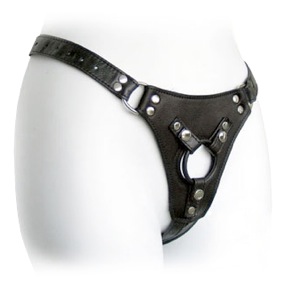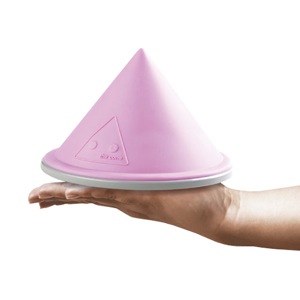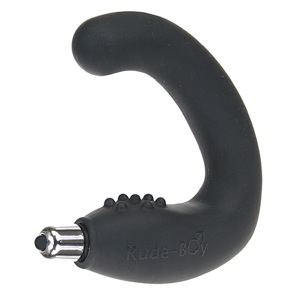feature
Sexxx Toys:
Everything you always wanted to know
Published Thursday, 23-Aug-2007 in issue 1026
The history of human sexual enhancement runs from whalebone dildos through high-tech cyber sex, and continues to evolve. We’ve compiled this collection of scintillating tidbits about sex toys and the adult industry as an at-your-fingertips reference for the bedroom and beyond.
State of the industry
The United States adult industry generated $13 billion in 2006, of which Internet pornography comprised $2.84 billion, according to AVN Media Network.
While it’s often assumed that gay men use a lot of sex toys, in the GLBT community, it’s women who lead sales. 60 percent of lesbians who responded to a 2002 Advocate poll reported using sex toys occasionally or frequently, compared with 31 percent of men.
While function is central to a sex toy’s efficacy, sex toy as objet d’art is coming into vogue. “In the last five years, design has evolved. Objects are now supposed to be beautiful as well as useful,” says Sarah Jacobs, curator of the N.Y. Museum of Sex, noting that several manufacturers now make toys out of glass and wood. One day, Jacobs says, it may be common for people to display their sex toys the same way we’d show off a beautiful painting or vase.
Beyond décor, sex toys play a role in shaping behavior and culture. The vibrator revolutionized societal concepts of women’s sexual capacity, for example. More recently, a different use for an old toy – the strap-on dildo – is enabling women to penetrate their partners , altering conventional female ‘roles’ in the bedroom. “In predominantly straight relationships, a lot of women are taking a dominant role [in sexual life],” says local sex toy retailer Bill Freyer, who co-owns Hillcrest’s Pleasures & Treasures with partner Tim Melodnick. Women are beginning to explore anal play with their male partners, Freyer says. “They’re starting to play with small toys and then progressing to a strap-on, so they can actually ‘do’ the male. I see this on a regular basis. The sexual revolution has taken on a totally different direction.” Sex columnist Dan Savage noted the strap-on’s new popularity for this purpose, called “pegging,” in the Aug. 7 issue of the Village Voice.
‘Green’ sex toys
In the past couple of years, concerns have arisen about the plastics commonly used in many erotic toys. “Many popular erotic toys are made of polyvinyl chlorides … plastics long decried by eco-activists for the toxins released during their manufacture and disposal – and softened with phthalates, a controversial family of chemicals,” writes Emily Gertz in a 2005 article for the environmental news site Grist.org. Gertz reports a German study that found 10 carcinogens in concentrations characterized as “off the charts” by experts.
Aside from metal and glass toys, Gertz lists several eco-friendly alternatives, such as a phthalate-free soft-plastic vibrator called I Rub My Duckie, by Big Teaze Toys, which according to the manufacturer “meet(s) strict toxicity safety standards for both the U.S. and the E.U.” The silicon substitute VixSkin is also an alternative to phthalate-based plastics, Gertz writes, adding that Vibratex recently reformulated its Rabbit Habit dual-action vibrator, “made famous on ‘Sex and the City,’” with this material. And Tantus Silicone produces dildos and anal toys that are made from hypoallergenic, medical-grade silicone that can be disinfected.
In 2002, the Federal Drug Administration issued a warning that infant males who were ill and undergoing treatment, as well as other “vulnerable patients,” could be harmed by phthalate exposure from vinyl medical devices.
In 2006, the National Toxicology Program reviewed the science and concluded that:
“There is serious concern that certain intensive medical treatments of male infants may result in DEHP [phthalates] exposures levels that affect development of the male reproductive tract.
“There is concern for adverse effects on development of the reproductive tract in male offspring of pregnant and breastfeeding women undergoing certain medical procedures that may result in exposure to high levels of DEHP.”
The Danish Environment Protection Agency last year released a “Survey and health assessment of chemical substances in sex toys.”
Some of the survey’s key findings include:
• moderate use of dildoes (less than 15 minutes per week) is not associated with any significant health risk
• heavy usage (1 hour per day) is not associated with any significant health risk, except for pregnant and breastfeeding women who should abstain from heavy usage
Other tips from the report include:
• avoid oil-based lubricants as they increase the transfer of phthalates
• don’t buy PVC toys
• use PVC toys with a condom
With regard to the publication of writing, photography and film, obscenity laws prevented unhindered freedom of expression well into the 1960s. According to Wikipedia.com, in 1957, the United States Supreme Court convicted Samuel Roth, who ran a literary business in New York, of sending “obscene, lewd, lascivious or filthy” materials through the mail to advertise and sell a publication called American Aphrodite, (“A Quarterly for the Fancy-Free”) containing literary erotica and nude photography. By 1966, however, in Memoirs v. Massachusetts, the Supreme Court found that only materials that were “patently offensive” and “utterly without redeeming value” were criminal, but the justices could not agree as to what constituted obscenity, and were increasingly confronted with cases reflecting the changing social morés of the 1960s. By 1969, following the Stonewall riots, writes Simon Sheppard, editor of the anthology Homosex: Sixty Years of Gay Erotica, “the golden age of paperback pulp porn novels was born. Publishers like Greenleaf Classics, Companion, and Blueboy churned out extensive lines of shoddily produced gay sex novels. …The covers might have been inartistic, the titles delightfully cheesy, but no longer were queers on the printed page condemned to skulk around and meet unpleasant ends. Now they could stroke and suck and fuck each other up the ass, and still wind up living happily ever after.”
By 1973, Miller v. California, determined that all obscenity was constitutionally protected in this state, unless distributed to minors or unwilling third-parties. However, in Utah, in 1990, Adam & Eve founder Phil Harvey, owner of the nation’s first mail-order contraceptive business, which began selling condoms before it got into the sex toy arena, was charged by a federal grand jury in Utah with multiple counts of mailing obscene materials to customers in Utah and informed that he, along with five other company members, faced 55 years in prison and $2.75 million in fines. After spending millions in legal fees Harvey filed a federal civil suit against the U.S. Department of Justice. In 1990 Harvey was acquitted by a jury of all charges.
The selling of sex toys is, however, still banned in a handful of states, including Alabama, Georgia, Texas and Mississippi. In 1998, the Alabama Legislature passed a ban on selling sex toys. Last May, the owner of an adult store in Alabama asked the Supreme Court to throw the ban out on the grounds that it is unconstitutional. An appeal was filed with the U.S. Supreme Court, and it is expected that the Court will either accept or deny review when it returns from summer recess. Last year, the Supreme Court refused to consider whether a Texas law that makes it a criminal activity to promote sex toys shaped like sexual organs is unconstitutional.
‘Erotica King’ pens ‘Hot, horny and historical’ anthology
Author/pornographer/sex columnist Simon Sheppard, whom San Francisco magazine dubbed “Erotica King,” has written numerous books of erotica, and his work has appeared in more than 200 anthologies including Best Gay Erotica 2007. Now he’s edited a new anthology of stories, Homosex: Sixty Years of Gay Erotica, released earlier this month by Carroll & Graf Publishers.
The book “ain’t just smut,” writes gay.com reviewer Jason Lamphier of Sheppard’s undertaking to compile more than half a century of gay erotica. “Sheppard tosses in monumental moments of our queer past from a sexual standpoint, touching on ’60s Berkeley and Vietnam, and even manages to squeeze in Indian tribes and gay vampires. Consider it one-handed reading for history buffs.”
The Gay & Lesbian Times spoke to Sheppard about his latest endeavor:
Gay & Lesbian Times: On your Web site, you call yourself a pornographer. What does that mean to you and why do you prefer this term?
Simon Sheppard: I call myself all sorts of other things too, including ‘erotic writer’ and ’smut smith.’ I like ‘pornographer’ because it’s cheeky and unpretentious. What, after all, is the difference between ‘porn’ and ‘erotica?’ People have said that erotica is better written, that it’s about feelings rather than just bodies, that it has context, that sex in erotica has consequences. Or that rich people read erotica, while the rest of us read porn. Whatever. I sometimes suspect that erotica is just a highfalutin term used to get books on the shelves at Borders. As long as readers enjoy what I do, they can call me whatever they want. But hey, I’m easy.
GLT: Why do you do the work you do?
SS: I write about gay sex because I love doing it, and I’ve been told I’m good at it. I also love queer sex and queer men, and in my more self-regarding moments, I look at what I do as ‘cultural work,’ … with a hard-on. It’s a pleasure to entertain, to explore sexuality, sometimes to educate or challenge, and I hope I give my readers pleasure too.
Storytelling and sex are two of the oldest, noblest of human pursuits, and putting together Homosex, which celebrates both, was a labor of love. It was fascinating to research and assemble, and I think readers will likewise find it engaging – and arousing.
GLT: Why did you choose to cover the last 60 years of gay erotica, rather than, say, the last
century?
SS: Well, one of the oldest printed pieces I happened to run across was a mimeographed memoir, “Navy Daze,” that was published in Tijuana in 1945. Back then, erotica of any sort was banned in the United States, and that book and others like it were destined to be smuggled back north over the border. Gay historians generally agree that the demobilization of soldiers after World War II contributed greatly to the flourishing of urban gay communities. And one of the themes of Homosex is that erotica has served as an often-underground discourse around queer issues. So while 1945 certainly doesn’t mark the first time that guys wrote about gay sex, that story, in which the Navy-vet narrator ended up in San Francisco, seemed a great place to start the book.
GLT: How has gay erotica evolved throughout the last couple of centuries? Has it changed?
SS: Well, Homosex restricts itself to American writing that was published at some point as ‘erotica’ or ‘porn,’ and that stuff just wasn’t out there until recently. Don’t forget that it took a Supreme Court decision for [James] Joyce’s Ulysses to legally make it to the land of the free. Even a 1950s story in the book, written by pornwriter icon Phil Andros, was passed around from hand to hand until it finally saw print in the 1960s. So there’s not a lot of evidence as to what sort of queer smut was being read at the Battle of Gettysburg.
I will [however] say that in the past 60 years, gay erotica has become more varied, and in some cases more ambitious and/or literate. But one of the pleasant surprises in my research was that even way before the birth of the modern gay movement, there were a lot of proto-liberation attitudes in some of the writings I found. While gay men were expected to end badly in pre-Stonewall aboveground fiction, in smut, sodomy could live happily ever after.
GLT: Is there a difference between GLBT and straight erotica?
SS: As far as written erotica goes, that comes down to whether there are differences between ‘queer consciousness’ and het mindsets. I’d say yes. But problematically, there’s gay male erotica out there that’s been written by women or straight men, often under pseudonyms, which complicates things.
GLT: Has gay erotica passed through different stages of public acceptability?
SS: Homophobia is culturally determined, not a constant. The great Roman Emperor Constantine made his dead boyfriend a god. In Imperial China, there was graphically gay ‘cut sleeve’ literature; and there are ancient visual representations of male/male sex from Pompeii to India. There was a boomlet in queer art in Weimar Germany, but Hitler put an end to that. And then there’s the whole question of whether “the homosexual” is a social construct of pretty recent vintage.
In the USA, progress is uneven,
partly because we live in a culture that’s both erotophobic and sexually obsessed. And even many progay straight liberals don’t particularly want to think about a guy fucking his boyfriend up the butt. Then too, there’s part of the gay community that would rather focus on our struggles for the right to adopt or serve in the Army than around the sex we have. Before the Supreme Court struck down state sex laws, there weren’t huge pro-sodomy demonstrations.
While it used to be that acquiring gay erotica was difficult, even dangerous, the Internet has let that genie out of the bottle. Even so, among straights, eroticizing the male body – therefore making men the objects, rather than subjects, of the gaze – can cause discomfort. You only have to watch Showtime for evidence: plenty of pussy, but no visible dick at all.
Interview with photographer Timothy Archibald
In a Nerve.com article, photographer Timothy Archibald describes how he came to compile his collection of shots of home-made sex toys, Sex Machines: Photographs and Interviews. The book includes images of independent sex machine inventors who, in their spare time, put together contraptions of every shape and size in basements and garages across the United States. Archibald happened on the subject while researching a story about inventors. He stumbled onto a small Web community of sex machine inventors, he writes on Nerve.com, and after also discovering that 15-20 different sex machines are listed on eBay daily, and that the archives of the U.S. Patent Office “brim” with early sexual devices, he knew he was onto something. “A peek into erotic world history reveals that people have been creating forms of sex machines since the invention of Cleopatra’s bumble-bee powered vibrator,” Archibald writes. “I now see the desire to create sex machines as instinctual. These inventors are not simply hip opportunists, but practitioners of a craft that will continue long into the future.”
The Gay & Lesbian Times spoke with Archibald about his work.
Why are the toys you document culturally significant?
The inventors…were interesting to me because I felt they were creating these objects almost as a form of folk art: each machine seemed to reflect the wants and needs of the creator, and often times the function was the first decision, and the form, as in the design, just seemed to be a secondary consideration. I felt that they were kind of working in a naïve and innocent way, thus the machines seemed to have those qualities as well. Nothing was really very self conscious about the inventors’ creations. They seemed to be coming directly out of the creators’ id, right from the brain and our into the world. As they represented the creators, they also, by extension, reflected society at large.
What do the toys say about us?
Well, I think these machines seem to represent what we want, or at least, what a handful of inventors wanted. But then again, these guys are selling these things; people are buying them. So the inventions are representing what society seems to want. And, as the saying goes, you can’t really control what you want, what you love, what you desire. This stuff is just in you. Or that’s what I believe at least.
What is the most ingenious toy you found?
The most ingenious and elaborate machine would be The Thrillhammer, which was being installed at The Chicken Ranch Brothel in Pahrump, Nevada by the inventor Allen Stein. (The book describes the machine and what it does, as does his Web site at www.thethrillhammer.com.)
|
|
Copyright © 2003-2025 Uptown Publications





